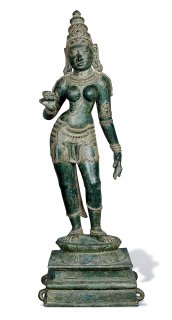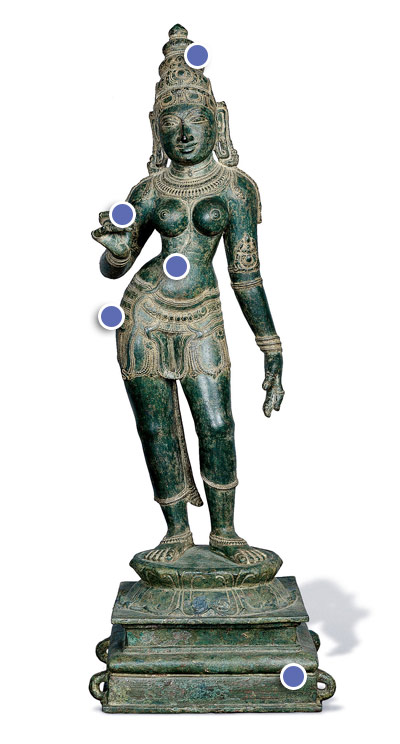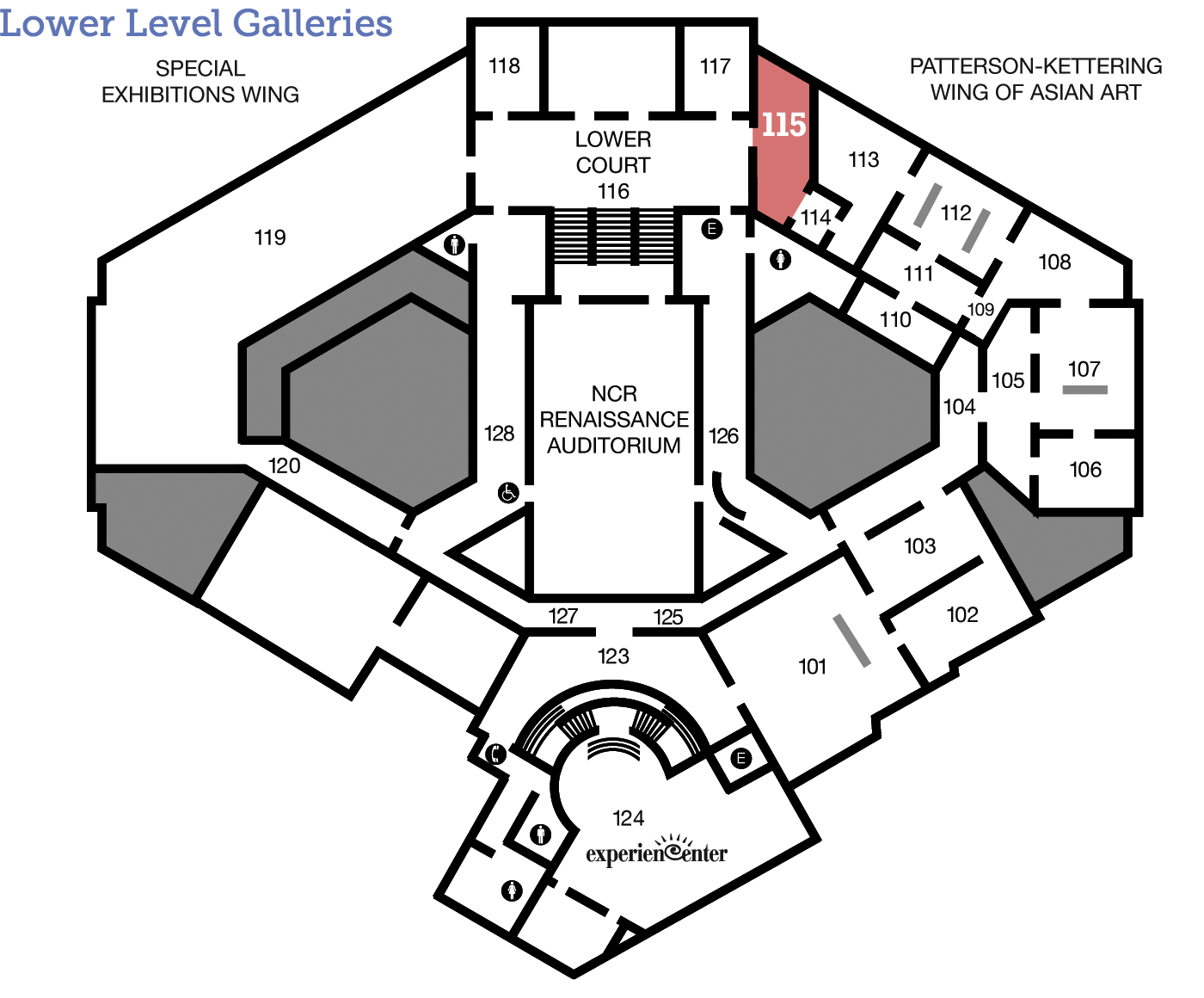
Indian
Goddess Parvati/Nadu Goddess
Chola dynasty (860–1279) Copper alloy Height: 30 ½ inches Museum purchase with funds provided by Mrs. Theodore C. Dye in memory of her husband Mr. Theodore Cole Dye 1966.46
Parade!
Does the divine have a place? Is it moving or stable? Is it visible or invisible? The lugs at the base of this thousand-year-old bronze sculpture of the Hindu goddess Parvati made it easy to carry in festival processions. Follow along and learn about an ideal concept of beauty and the divine.
A Day in the Life
Beautiful and Useful
While this sculpture can be admired for its fine craftsmanship and formal features, it is important to remember that it had a practical function. It is an example of an utsavmurtis, an image of a god or goddess that would be carried in a festival and housed in a temple other times. Furthermore, the divine figure, Parvati, would be adorned with colorful silks, flower garlands, and other accessories, expressions of love and care from her devotees. And practices like this continue today, for the Hindu tradition is an important part of the experience of millions of people around the world, including residents of the Cincinnati-Dayton area.
Tools and Techniques
Behind the Scenes
Look Closer
Just for Kids
Signs & Symbols
From Head to Toe
This sculpture was made during the Chola dynasty, which lasted from the 9th to the 13th century and covered the area of the modern state of Tamil Nadu in the south of India. During this time bronze casting reached a high level of sophistication. Craftsmen used this technology in combination with artistic traditions that emphasized techniques for making ideal and uniform figures. There were standard measurements and forms for the best proportions in body parts, and standard symbols that helped identify different figures. These had developed over time and were gathered in writings known as the shilpa shastras (“science of craft”). Tap on the different parts of the sculpture to learn more.

Dig Deeper
Arts Intersected
Beauty in Shape, Beauty in Syllables
The goddess Parvati is also a popular subject in classical Indian literature. Her relationship with Shiva is the subject of the epic poem Kumarasambhava by Kalidasa, the greatest writer of the Sanskrit language. Consider how the following passage about the surpassing beauty of Parvati compares with the way the sculpture presents her.
Like a painting unfolding under the brush
or a lotus spreading open at the sun’s touch,
every part of her body had its perfect
symmetry in the fresh fullness of her youth.She had thighs so lovely, rounded and even,
and long but not too long, that it seemed her maker
must have summoned up a great effort of creation
to match the glow of them in the rest of her limbs.Lightly moving and black as if painted in by a pencil,
the long lines of her eyebrows drew desire,
and when he saw her, the God of Love [Shiva] lost
all his pride in the curved beauty of his brow.She was a collection of all things that are natural
similes for beauty, each one in its right place,
Fashioned by the universal creator with his full energy,
As if eager to see all beauty in a single form.(1.32, 35, 47, 49)
Kalidasa, The Origin of the Young God: Kalidasa’s Kumarasambhava, translated by Hank Heifetz (Berkeley: University of California Press, 1985).
The Sculpture Speaks
Did You Know?
Expert Opinion
Look Around
Family Ties
Parvati is one manifestation of the Hindu figure of The Goddess, the female creative energy (shakti) that animates the male gods. Parvati is the form of The Goddess as the wife of Shiva. In Indian art, Shiva and Parvati are often shown together, an image of perfect love and the union of male and female principles. You can see this in another object in The DAI’s collection, Shiva and Parvati. The sculpture is a snap-shot of family intimacy, Shiva and Parvati smiling and gently touching each other while their children—the elephant-headed Ganesha, remover of obstacles, and Skanda, the god of war—play about their feet, along with other attendants.
Indian, Shiva and Parvati, late 8th–early 9th century, red sandstone. Museum purchase with funds largely provided by the Honorable Jefferson Patterson, the 1966 Art Ball, and other sources, 1966.26
Further reading: George Michell, Catherine Lampert, and Tristram Holland, eds., In the Image of Man: The Indian Perception of the Universe through 2000 Years of Painting and Sculpture (New York: Alpine Fine Arts Collection, Ltd., 1982).
About the Artist
Talk Back
It was the Best of Times
The Chola dynasty was one of the most stable and enduring in India’s history. During that time the arts flourished, including cast-bronze sculptures such as this one. To what extent does the quality of the arts in a particular time and place depend on political, social, or economic stability? What other factors may contribute to a vibrant arts culture?

